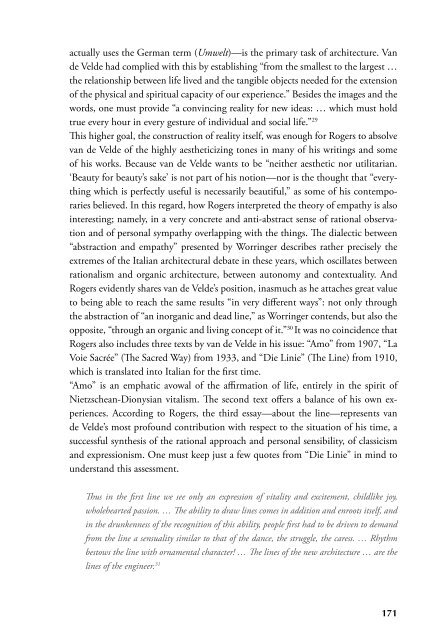The Death and Life of the Total Work of Art – Henry van de Velde and the Legacy of a Modern Concept
ISBN 978-3-86859-261-0
ISBN 978-3-86859-261-0
Create successful ePaper yourself
Turn your PDF publications into a flip-book with our unique Google optimized e-Paper software.
actually uses <strong>the</strong> German term (Umwelt)—is <strong>the</strong> primary task <strong>of</strong> architecture. Van<br />
<strong>de</strong> Vel<strong>de</strong> had complied with this by establishing “from <strong>the</strong> smallest to <strong>the</strong> largest …<br />
<strong>the</strong> relationship between life lived <strong>and</strong> <strong>the</strong> tangible objects nee<strong>de</strong>d for <strong>the</strong> extension<br />
<strong>of</strong> <strong>the</strong> physical <strong>and</strong> spiritual capacity <strong>of</strong> our experience.” Besi<strong>de</strong>s <strong>the</strong> images <strong>and</strong> <strong>the</strong><br />
words, one must provi<strong>de</strong> “a convincing reality for new i<strong>de</strong>as: … which must hold<br />
true every hour in every gesture <strong>of</strong> individual <strong>and</strong> social life.” 29<br />
This higher goal, <strong>the</strong> construction <strong>of</strong> reality itself, was enough for Rogers to absolve<br />
<strong>van</strong> <strong>de</strong> Vel<strong>de</strong> <strong>of</strong> <strong>the</strong> highly aes<strong>the</strong>ticizing tones in many <strong>of</strong> his writings <strong>and</strong> some<br />
<strong>of</strong> his works. Because <strong>van</strong> <strong>de</strong> Vel<strong>de</strong> wants to be “nei<strong>the</strong>r aes<strong>the</strong>tic nor utilitarian.<br />
‘Beauty for beauty’s sake’ is not part <strong>of</strong> his notion—nor is <strong>the</strong> thought that “everything<br />
which is perfectly useful is necessarily beautiful,” as some <strong>of</strong> his contemporaries<br />
believed. In this regard, how Rogers interpreted <strong>the</strong> <strong>the</strong>ory <strong>of</strong> empathy is also<br />
interesting; namely, in a very concrete <strong>and</strong> anti-abstract sense <strong>of</strong> rational observation<br />
<strong>and</strong> <strong>of</strong> personal sympathy overlapping with <strong>the</strong> things. <strong>The</strong> dialectic between<br />
“abstraction <strong>and</strong> empathy” presented by Worringer <strong>de</strong>scribes ra<strong>the</strong>r precisely <strong>the</strong><br />
extremes <strong>of</strong> <strong>the</strong> Italian architectural <strong>de</strong>bate in <strong>the</strong>se years, which oscillates between<br />
rationalism <strong>and</strong> organic architecture, between autonomy <strong>and</strong> contextuality. And<br />
Rogers evi<strong>de</strong>ntly shares <strong>van</strong> <strong>de</strong> Vel<strong>de</strong>’s position, inasmuch as he attaches great value<br />
to being able to reach <strong>the</strong> same results “in very different ways”: not only through<br />
<strong>the</strong> abstraction <strong>of</strong> “an inorganic <strong>and</strong> <strong>de</strong>ad line,” as Worringer contends, but also <strong>the</strong><br />
opposite, “through an organic <strong>and</strong> living concept <strong>of</strong> it.” 30 It was no coinci<strong>de</strong>nce that<br />
Rogers also inclu<strong>de</strong>s three texts by <strong>van</strong> <strong>de</strong> Vel<strong>de</strong> in his issue: “Amo” from 1907, “La<br />
Voie Sacrée” (<strong>The</strong> Sacred Way) from 1933, <strong>and</strong> “Die Linie” (<strong>The</strong> Line) from 1910,<br />
which is translated into Italian for <strong>the</strong> first time.<br />
“Amo” is an emphatic avowal <strong>of</strong> <strong>the</strong> affirmation <strong>of</strong> life, entirely in <strong>the</strong> spirit <strong>of</strong><br />
Nietzschean-Dionysian vitalism. <strong>The</strong> second text <strong>of</strong>fers a balance <strong>of</strong> his own experiences.<br />
According to Rogers, <strong>the</strong> third essay—about <strong>the</strong> line—represents <strong>van</strong><br />
<strong>de</strong> Vel<strong>de</strong>’s most pr<strong>of</strong>ound contribution with respect to <strong>the</strong> situation <strong>of</strong> his time, a<br />
successful syn<strong>the</strong>sis <strong>of</strong> <strong>the</strong> rational approach <strong>and</strong> personal sensibility, <strong>of</strong> classicism<br />
<strong>and</strong> expressionism. One must keep just a few quotes from “Die Linie” in mind to<br />
un<strong>de</strong>rst<strong>and</strong> this assessment.<br />
Thus in <strong>the</strong> first line we see only an expression <strong>of</strong> vitality <strong>and</strong> excitement, childlike joy,<br />
wholehearted passion. … <strong>The</strong> ability to draw lines comes in addition <strong>and</strong> enroots itself, <strong>and</strong><br />
in <strong>the</strong> drunkenness <strong>of</strong> <strong>the</strong> recognition <strong>of</strong> this ability, people first had to be driven to <strong>de</strong>m<strong>and</strong><br />
from <strong>the</strong> line a sensuality similar to that <strong>of</strong> <strong>the</strong> dance, <strong>the</strong> struggle, <strong>the</strong> caress. … Rhythm<br />
bestows <strong>the</strong> line with ornamental character! … <strong>The</strong> lines <strong>of</strong> <strong>the</strong> new architecture … are <strong>the</strong><br />
lines <strong>of</strong> <strong>the</strong> engineer. 31<br />
171


















